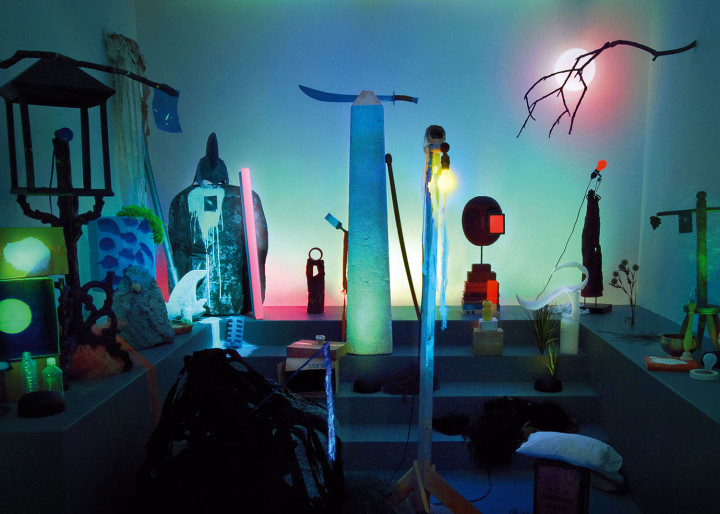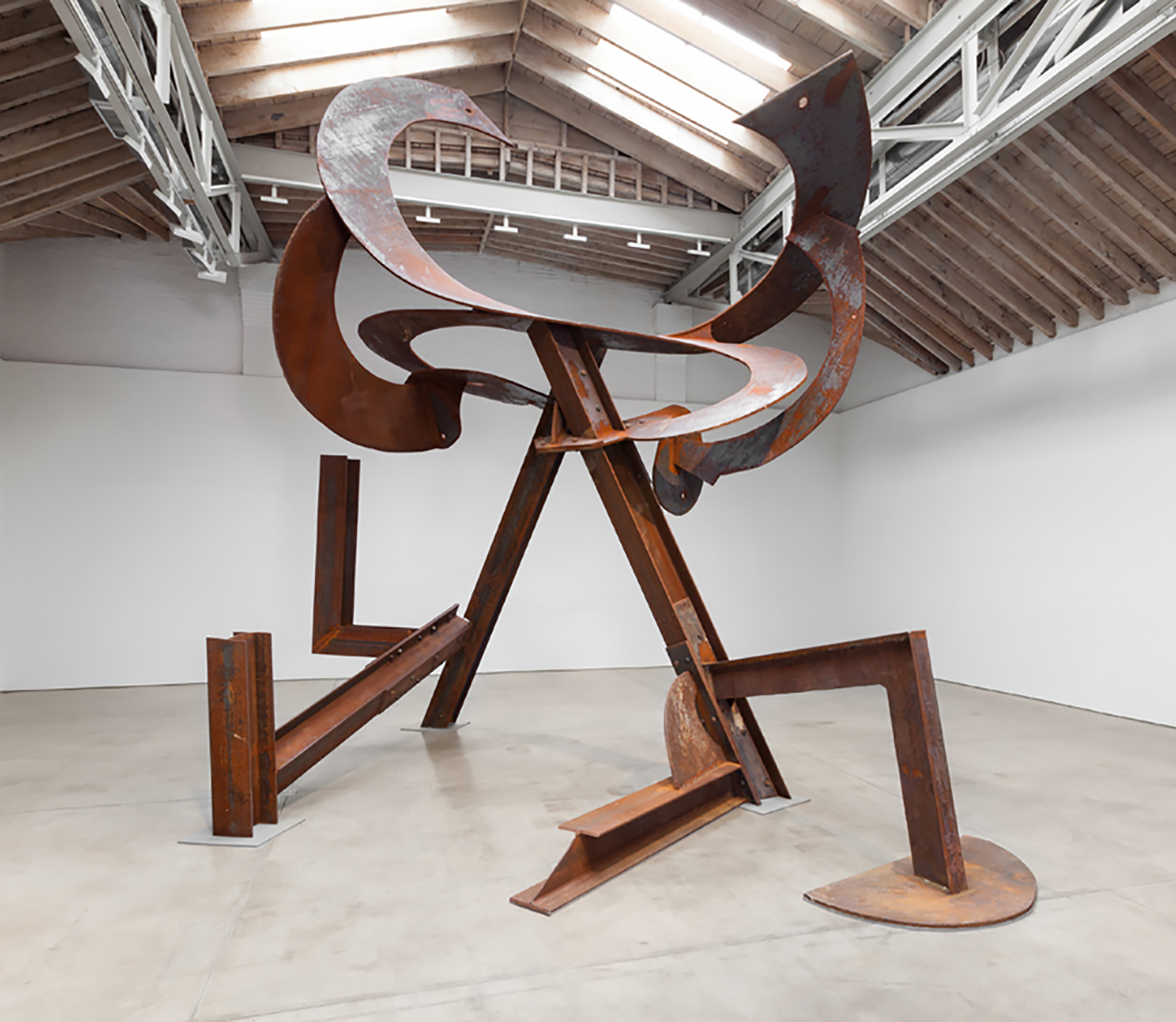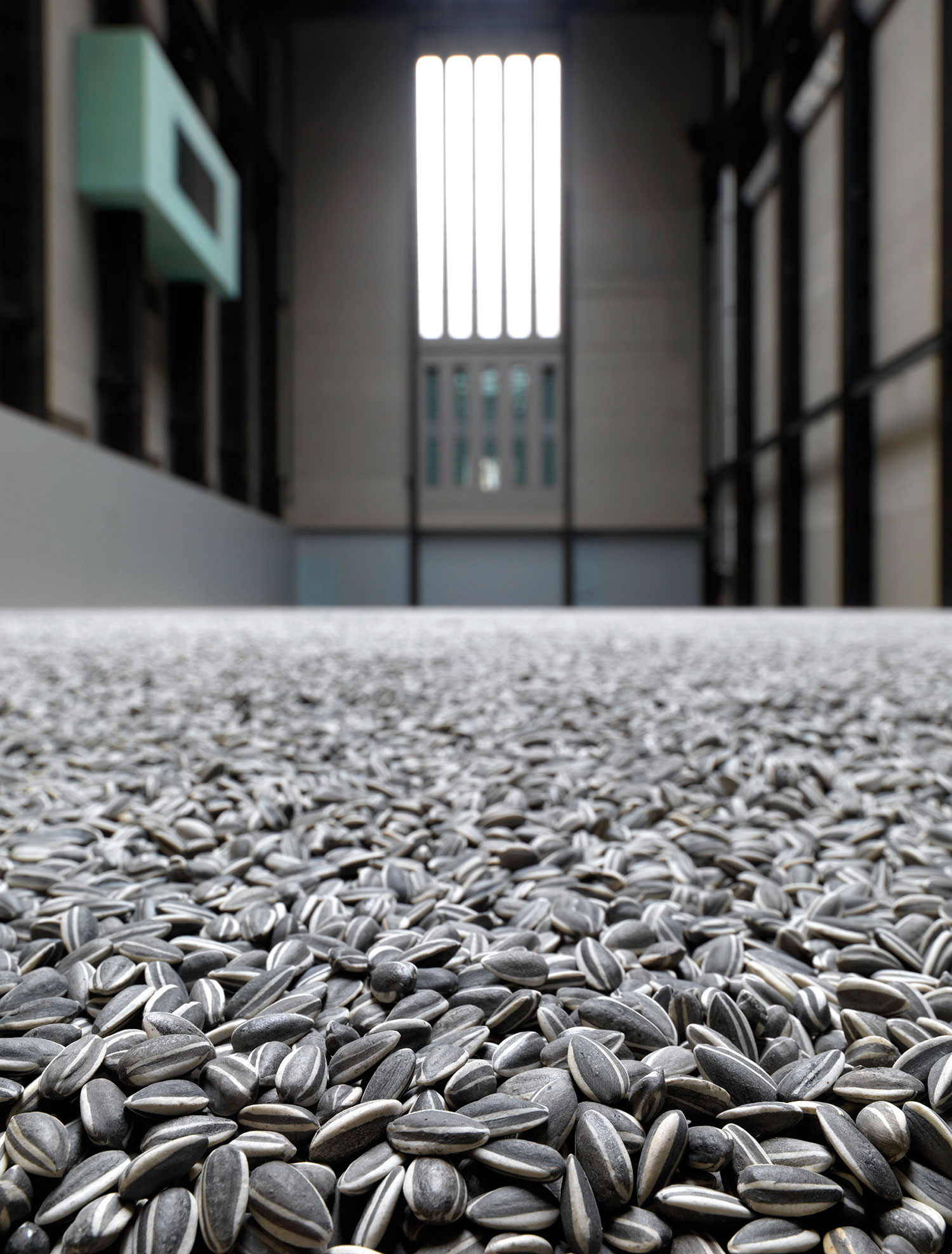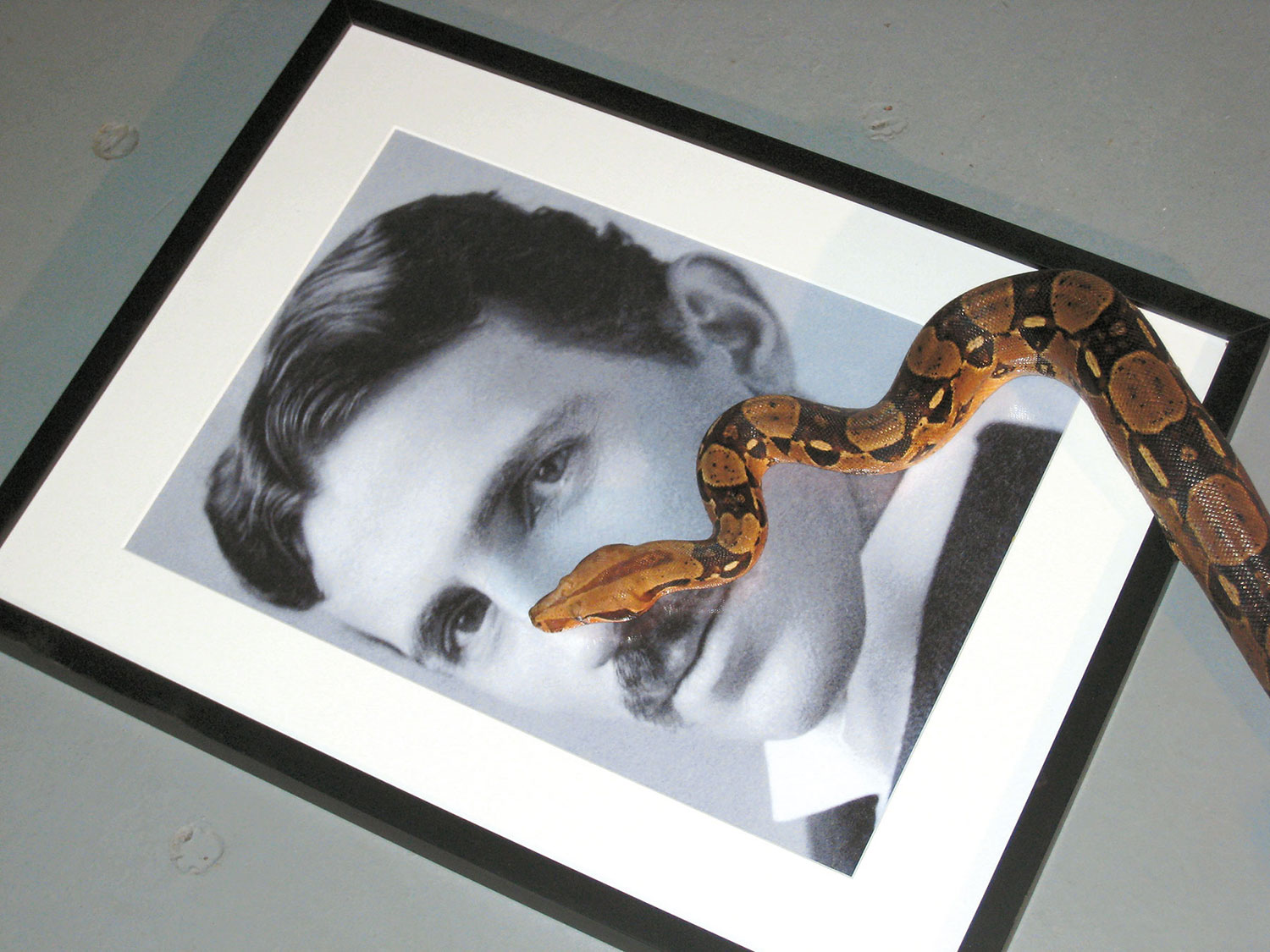
The imagination is the first luxury of a body that receives sufficient nourishment, of a person who has just a bit of spare time, and whose surrounds provide just the rudiments from which dreams are made.
— Geoffrey Farmer 1
In recent years some very daring and thought-provoking artists have been embracing a new theatricality in visual art by breaking boundaries across artistic practices and reworking modern forms in theater and dance through homage, mirroring and reinvention. They are addressing the formal and informal stage as a location for conjoining hyper-individuality and collectivity, and adapting traditions in these forms to a ‘spatialized’ orientation of performance through the physical body, props, set and curtain. Historical references, often many disparate ones within a single work, emerge as specific sources, and these familiar images are reclaimed for constructing new meanings. The artists’ repeated references to ghosts from the past and their inevitable companions, mortality and death, are summoned up through performance and presented to audiences in both live and photo-based mediums. Very much present are references to Commedia dell’Arte, the figure of the harlequin and Venetian Carnival; late 19th-century tableau vivant practiced by amateur theater troupes; the Dada performances of Hugo Ball at Cabaret Voltaire; and the Bauhausian Triadic Ballets of Oskar Schlemmer.
As art historian Patricia Falguières points out, modern visual artists in the early 20th century behaved differently from their theater contemporaries when considering bodies and objects in staged settings. She writes: “In question here, as much as the virtualization of space and of the operations of marking out what are its corollary, is the fundamental transformation undergone in the 20th century by objects and actors on stage; like the elements of what was usually called the set, characters too entered into that figural logic called for by [Antonin] Artaud, making copious use of masks, megaphone, dummies, stilts, and puppets.”2 For these artists, sources as varied as Carnival and Rudolf Laban’s movement theory are access points for experimentation with subjective belief systems — the occult, magic and ritual. Why are their fantasy-infused worlds filled with remnants of history?
Central to this discussion is the crisis of the formal stage as a site, which is dependent on clear boundaries in its illusionistic separation between performers and spectators. With an aim of engaging the audience on a heightened physical level, Spartacus Chetwynd and assume vivid astro focus (avaf) often move the stage to a club or procession creating experiential collectivities through ceremony, improvisation and chance. Daria Martin and Kelly Nipper, in some sense successors to innovators in dance such as Anna Halprin and Yvonne Rainer, are also exposing the mechanics of performance that were half-hidden in Bertolt Brecht’s plays. Geoffrey Farmer, Ulla von Brandenburg and Enrico David rely on inference and absence to trigger ghostly collective memories by creating ‘visualities’ for internalized fears that are social or para-social in nature. Whether the artist leans towards excessive camp or highly controlled revisions of modernist forms, each of them offers up what Alain Badiou describes as “relationships between the visible and the invisible in theatrical (or non-theatrical) action. Here I call ‘invisible’ the instructions or statements which you rightly identify as being ‘between’ the idea and the act.”3 These artists are taking the invisible into new directions, furthering strands of artistic motivations that were emergent in earlier forays, where performance is comfortably situated within the spatialism of visual art.
Farmer’s sculptural installations are unstable units of assemblage-style objects highly evocative of situations of human interaction. Functioning like changeable pseudo-tableaux vivants, the character-objects and prop-objects are configured as if in a play that is both open-ended and spontaneous. The static becomes non-static through a form of puppetry that barely reveals the magic in the visible. The psychological effect of his endeavor is heightened by the lowly origin of his leftover materials. The most extensive example of Farmer’s ingenious practice is i am by nature one and also many, dividing the single me into many, and even opposing them as great and small, light and dark, and in ten thousand other ways (2001-ongoing) where numerous arrangements suggest the infinite possibilities of which only some are selected. In one instance, a prairie woman is situated not far from a scarecrow and a tattered witch with a broom. Another witch made of draped black fabric with a body implied, has eyeholes that have been cut out, which prevent the possibility of the gaze. Throughout, the aura of death is animated through the inanimate.

A dancer in a skeleton costume is the sole performer in von Brandenburg’s film Tanz, Makaber (Dance, macabre, 2006). The simple steps are repeated as if it would be impossible to stop moving. In Geist (Ghost, 2007), a figure draped in a white sheet walks away from a camera in a field seen through a reflecting ball. For Reiter (cavelier, 2004), a tableau vivant framed by a curtain with a diamond-shaped black-and-white harlequin pattern incorporates three specific references: Tiepolo’s baroque paintings of the Venice Carnival, Goethe’s poem “Ginkgo Biloba” and Pierre Klossowski’s designs, which all collapse into a single scene.4 The harlequin-patterned curtain, which reappears with an addition of segments of orange diamonds in Curtain II (2009), again channels an experience with a past that haunts the present, to eerie effect.5
Von Brandenburg exploits the curtain as demarcation of the boundary between the illusionism of the stage and the real world populated by audiences. In Five Folded Curtains (2008), an empty mise-en-scène becomes a site for the spectator to become an actor. Each of the five versions offers different opportunities for approach, entry and concealment. The stage curtain is the architectural equivalent to the mask, an object that delivers a liminal space between interiors and exteriors, between fantasy and the real world. “The theatrical middle zone proposes a genuine transferral of attention towards inter-subjective relations, revealing the blurredness of life and art …”6 In Nipper’s Evergreen (2004), the mechanics of the stage and the deflation of its artifice are indicated by a technician appearing in front of the curtain to set up a microphone. In addition, the femininity of the curtain as skirt becomes a metaphor for that which is revealed or concealed.
Spartacus Chetwynd’s grotesqueries wrestle with a potpourri of cannibalized references borrowed from street theater, literature, pop culture and Carnival. Her bacchanalian escapades embrace popular social aesthetics while maintaining strong ties to medieval pageantry and amateur traveling troupes. In the scenes of celebratory collectivity in Hermito’s Children, Episode 1, (2009), her pilot TV show, a variety of characters feast together, taunt innocence and revel in naked harmony. The carnivalesque space is in keeping with Mikhail Bakhtin’s notions derived from the study of François Rabelais — an avenue whereby a culture is able to renew and revive itself from within. While this work retains a storyline, it is the celebration of the sexualized body, the suggestion of a true epicurean potential mixed with pagan-style ritual, puppetry and post-pop cabaret casualness marked with inventive personas that drives its confluence of alternative lifestyles and spiritualities. Similarly, in the spirit of Brazilian Carnival assume vivid astro focus’s costumed extravaganzas presume commonality for large heterogeneous general audiences. Their post-pop events embrace the continuity connecting campy gay club cultures and Carnival, which was itself adapted from the Venetian version. Their continual transformations — a procession becomes a sculpture, an installation becomes a workshop, revelers are changed into moving sculptural forms — express the fluidity between life and death within the cycles of ritual.

Whereas avaf exploits overt sources, Enrico David recodes received symbols and forms to represent his most intimate experiences. Bulbous Marauder (2008) was inspired by a private sexual encounter of “tea bagging,” where he noticed that up close the scrotum took on a crisscross diamond-like pattern. This memory became a catalyst for the two figures in dance poses. The mask form, which reveals a single eye and teeth, quotes the harlequin black half-mask. A black chin-piece of the traditional mask and the eyeholes convey a similar astonishment, sensuality and craftiness. The simultaneously aggressive and seductive pose of the figures prioritizes the dark side of the harlequin’s role, and the sword, often depicted in the shape of a bat, reverts to the image of the scrotum. For David, Art Deco style and the Bauhaus are visual sites ready for repurposing. He states, “I am attracted by the aesthetic resolution of the work of Schlemmer for its sense of completeness, a sophisticated innocence and harmony. I am fascinated by this harmonization as a potential vehicle for a certain friction, the gaps that I identify, the queer potential left to be colored in.”7 Kelly Nipper’s instructional dance videos prioritize the functional body where movement is stripped down to codified gestures and shapes. As different as they are, Nipper’s and David’s projects share common ground in their fascination with the symbolic affect of gestural forms in dance. In Nipper’s small collage sketch for Shifting Shapes (3, 6, 9, 12) (2010), a female dancer is in a balletic pose, her face hidden behind a facemask with one leg and the chest indicated by skeletal elements. This partial image of death (which is also a reference to Laban’s analytic movement system) is in playful dialogue with David’s more menacing male figures.8 Another reference-based work, Weather Center (2009), features a solo performance, which was inspired by Mary Wigman’s German Expressionist Witch Dance (1914). The fixed emotion of the mask contrasts with the flows and twists of the solo seated dancer.9
Daria Martin’s film sequences accumulate into mysterious, ghostly and magical effect placing invisible pressure on the gesture of the body and relational expressions between the performers.10 Her aesthetic experimental mysticism is marked by formal underpinnings and collaboration with an intimate group of artists including performer Nina Fog and composer Zeena Parkins. In her early trilogy In the Palace (2000), Birds (2001) and Closeup Gallery (2003), live performance is available only through the mediation of the camera shots. Almost tableaux vivants, the masks, sets and sculptural mise-en-scène both conceal and reveal the play between the ensemble and the individual in carrying the elements of narrative where intimacy, seduction, eroticism and fear appear and fall away. In the Palace draws directly from Schlemmer’s Slat Dance (1927). The film “contains a kind of petrified ecstasy, both sexual and fantastical, corrupting remembered fragments of theater, art and of dance history…”11 The transparent masks in Birds reference Ball’s Cabaret Voltaire costumes made of cardboard that feature the donning of a white-striped witch doctor’s hat.
It seems that each of these artists is making contact with death by entrusting performance with the power to achieve mystical or elated states. They pay homage to some piece of an artistic past as if this strange layer before the present, by its own agency, needs to be resuscitated. Like Tadeusz Kantor (1915-1990), these artists see all elements that form the theatrical scene to be important, rather than one being subservient to another. Going beyond quoting, they are inventing new forms out of acknowledged visual and performance histories. Their works have emerged from the gaps between distinct art forms to achieve integrated and elaborately textured taxonomies that rebound, deflect and reflect on received artistic categories.





